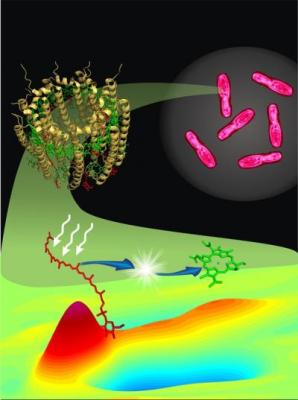Apr 5 2013
Pigments found in plants and purple bacteria employed to provide protection from sun damage do more than just that. Researchers from the University of Toronto and University of Glasgow have found that they also help to harvest light energy during photosynthesis.
 Advanced optical probes using femtosecond lasers enable light harvesting processes to be examined in exquisite detail. Anticlockwise from top right: Purple bacteria and the structure of the light harvesting complex that gives these cells their distinctive purple color. (Illustration: Evgeny Ostroumov)
Advanced optical probes using femtosecond lasers enable light harvesting processes to be examined in exquisite detail. Anticlockwise from top right: Purple bacteria and the structure of the light harvesting complex that gives these cells their distinctive purple color. (Illustration: Evgeny Ostroumov)
Carotenoids, the same pigments which give orange color to carrots and red to tomatoes, are often found together in plants with chlorophyll pigments that harvest solar energy. Their main function is photoprotection when rays of light from the sun are the most intense. However, a new study published in Science this week shows how they capture blue/green light and pass the energy on to chlorophylls, which absorb red light.
"This is an example of how nature exploits subtleties that we would likely overlook if we were designing a solar energy harvester," says Greg Scholes, the D.J. LeRoy Distinguished Professor in the Department of Chemistry at the University of Toronto and lead author of the study.
A series of experiments showed that a special "dark state" of the carotenoid – a hidden level not used for light absorption at all – acts as a mediator to help pass the energy it absorbs very efficiently to a chlorophyll pigment.
The researchers performed broadband two-dimensional electronic spectroscopy – a technique used to measure the electronic structure and its dynamics in atoms and molecules – on light-harvesting proteins from purple bacteria. The aim was to characterize in more detail the whole sequence of quantum mechanical states of carotenoids that capture light and channel energy to bacteriochlorophyll molecules. The data revealed a signature of a special state in this sequence that was predicted decades earlier, and sought ever since. The results point to this state's role in mediating energy flow from carotenoid to bacteriochlorophyll.
"It is utterly counter-intuitive that a state not participating in light absorption is used in this manner," says Scholes. "It is amazing that nature uses so many aspects of a whole range of quantum mechanical states in carotenoid molecules, moreover, and puts those states to use in such diverse ways."
The other significant aspect of the work is that the existence of these dark states has been speculated for decades and that the report by Scholes and his colleagues is the clearest evidence to date of their existence.
"We found a smoking gun for the state predicted decades ago and argued about ever since," says Scholes.
"The energy transfer processes in natural light-harvesting systems have been intensively studied for the last 60 years, yet certain details of the underlying mechanisms remain controversial. Our work really clears up this particular mystery," says Richard Cogdell, the Hooker Professor of Botany at the University of Glasgow, co-author of the report.
"It makes us look differently at the potential of molecules as building blocks," Scholes says. "Just imagine one molecule, a carotenoid, that can be used to harvest light, photoprotect, convert to a 'safety valve' in bright light to dissipate excitations, or even be employed as a heat transducer by purple bacteria such as are found in the black hole on the island of San Andros in the Bahamas."